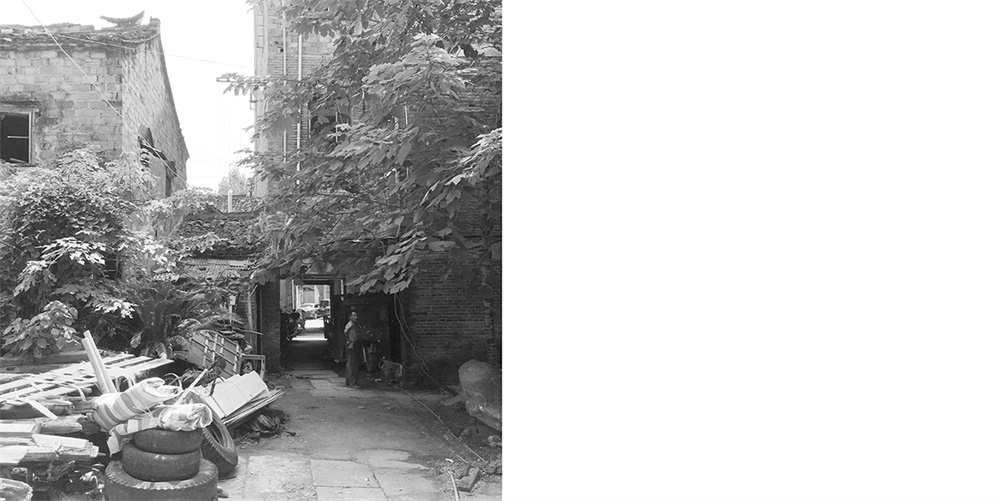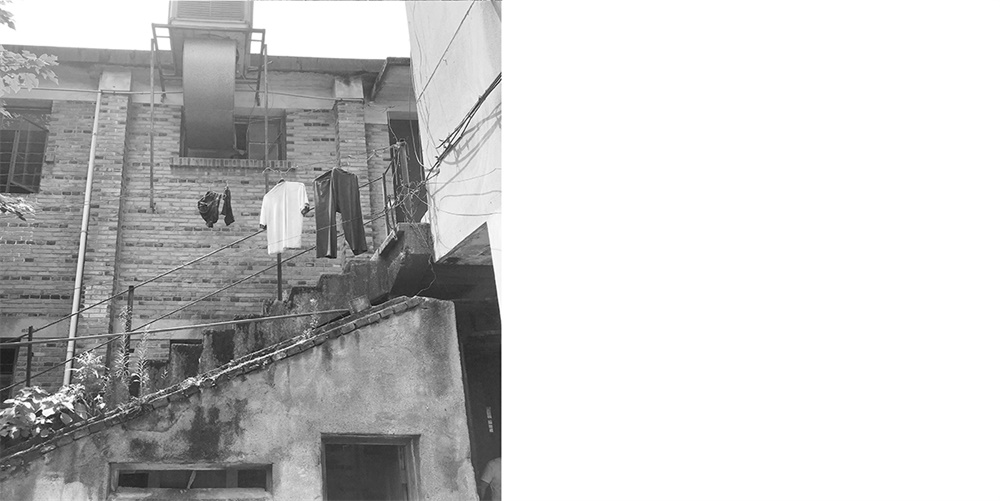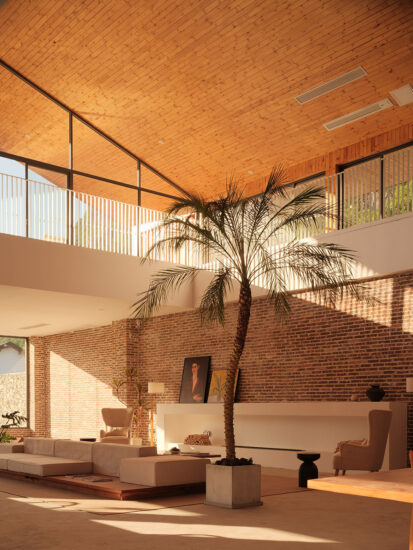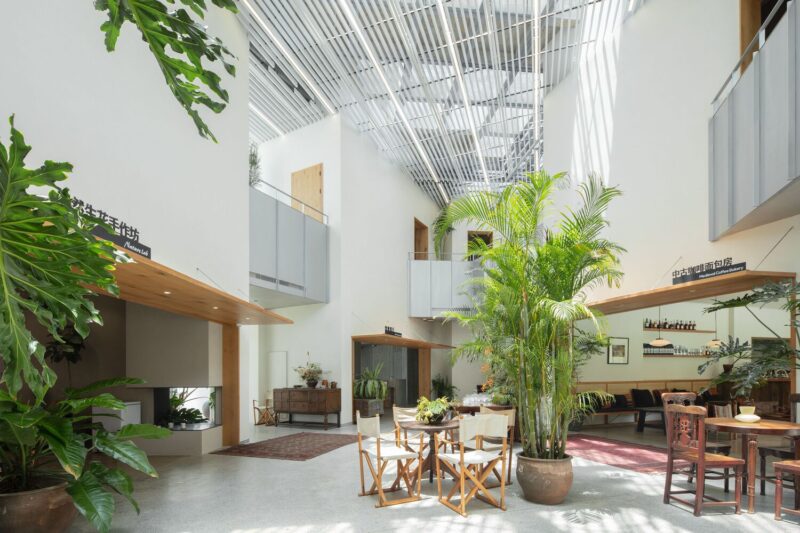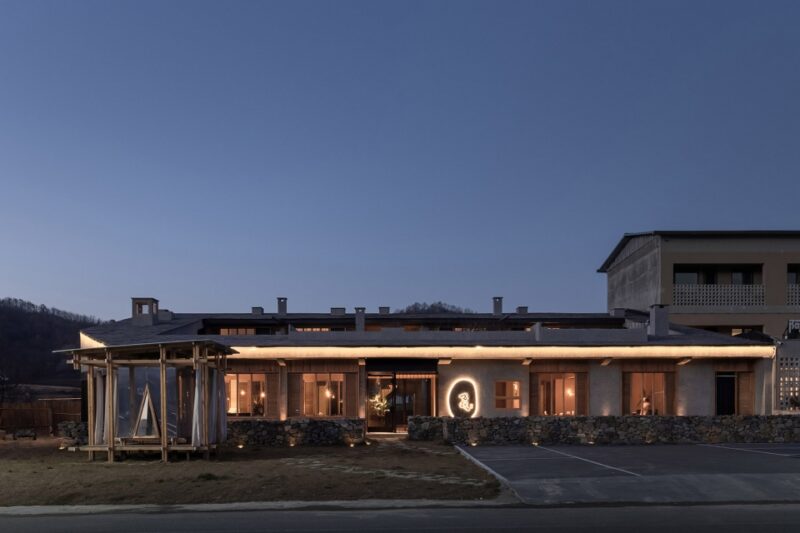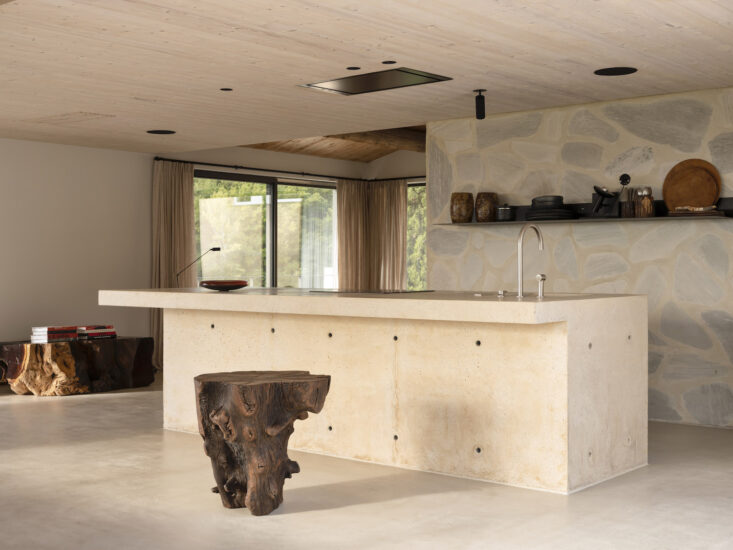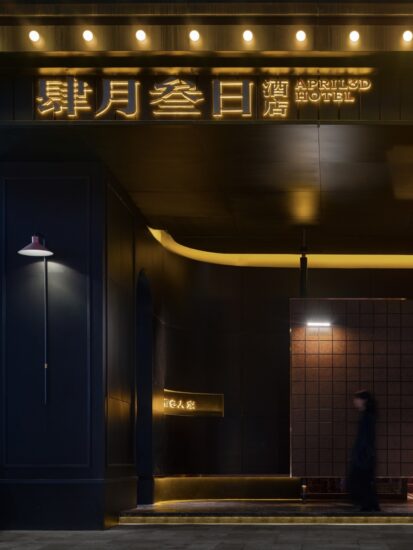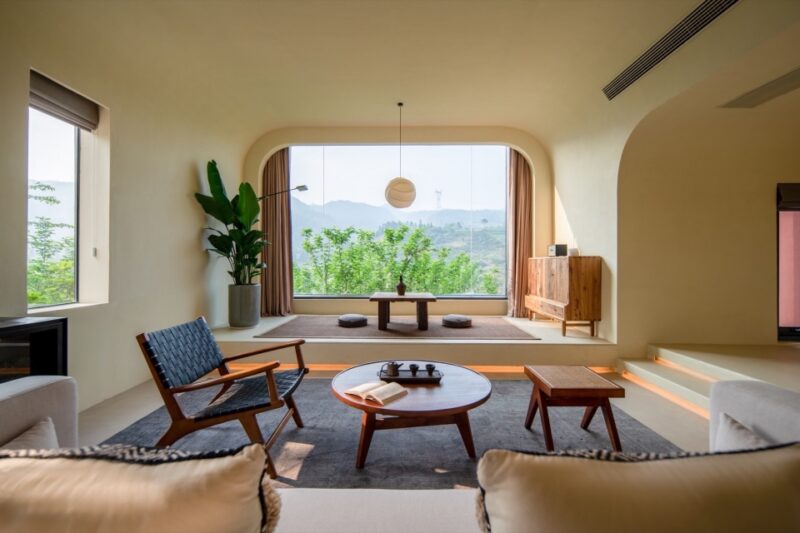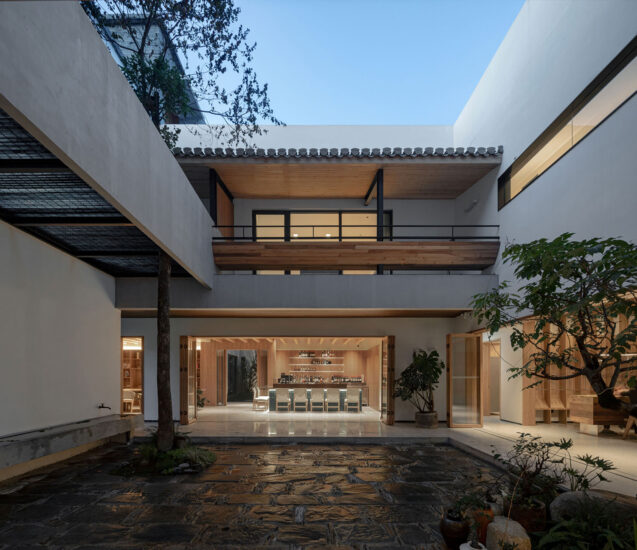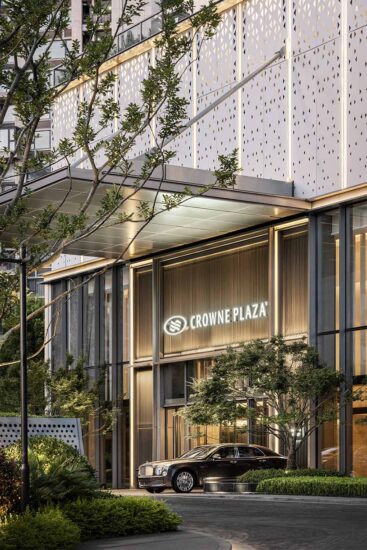全球設計風向感謝來自 零壹城市建築事務所 的民宿項目案例分享:
時空回廊丨臨海餘豐裏民宿
Time and Space Corridor_ Linhai Yufengli Homestay
∇ 四合院書館,攝影:吳清山 Courtyard Bookstore, photo: Wu Qingshan
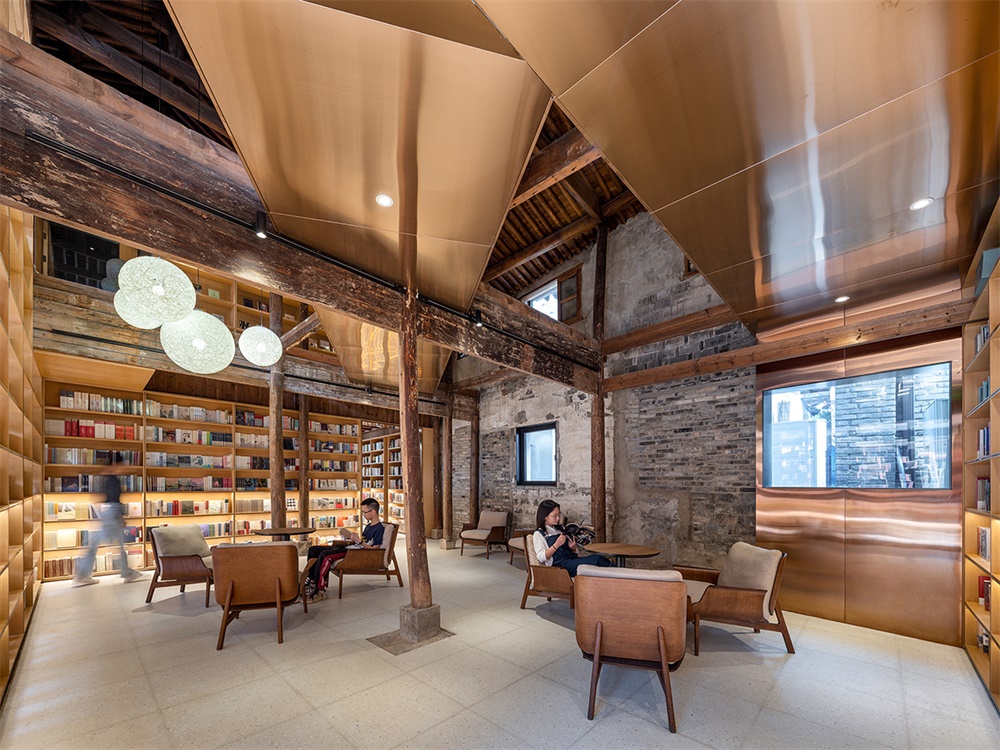
臨海餘豐裏民宿位於浙江臨海台州府城古鎮的赤城路老街口,是一個建築麵積近4000平方米的改造項目,由零壹城市建築事務所從建築、室內、軟裝到VI係統一體化設計。它的前身是一間百年老當鋪,由一座具有100多年曆史的四合院、兩棟60年曆史的磚混工業用房,以及兩棟30多年曆史的舊倉庫組成。
Yufengli Homestay is located at the corner of Chicheng Road in the ancient town of Linhai, Zhejiang Province. It is a reconstruction project of nearly 4,000 sq.m, which architecture, interior, soft decoration and VI system all designed by LYCS Architecture . Its predecessor is a century-old pawnshop, consisting of a courtyard with a history of more than 100 years, two brick-concrete industrial houses with a history of 60 years, and two old warehouses with a history of more than 30 years.
∇ 主入口界麵,攝影:吳清山 Main Entrance, photo: Wu Qingshan
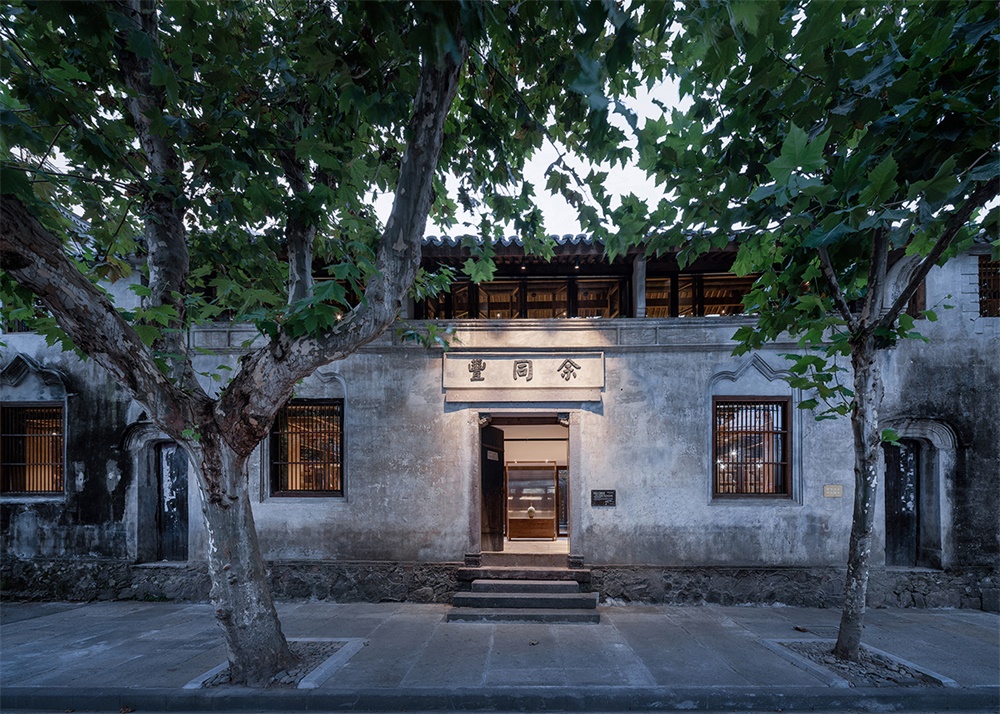
整個台州府城古鎮仍然保留著大量曆史古建築,而作為項目所在地的紫陽老街還延續著傳統的街坊生活方式,這裏是臨海千年古城的文化血脈,是古城遺址的縮影,就像是一個活的曆史建築館。項目起初就提出了挑戰:麵對同時存在3種不同年代的建築,跨越百年的曆史,新改造的介入如何讓舊與新、傳統與未來的對話創造全新的居住空間體驗?這不僅是這一項目的核心思考,也是零壹城市對新居住模式、城市更新的進一步探索。
The entire ancient block still retains a large number of historical buildings and continues the traditional neighbourhood lifestyle. It’s like a living historical building museum. At the beginning of the project, a challenge was raised: how can the new renovation create a new living space experience in the face of buildings of three different ages? This is not only the core thinking of this project, but also the further exploration of the new residential model and urban renewal by LYCS Architecture.
∇ 內庭院,攝影:吳清山 After: Inner Courtyard Landscape, photo: Wu Qingshan
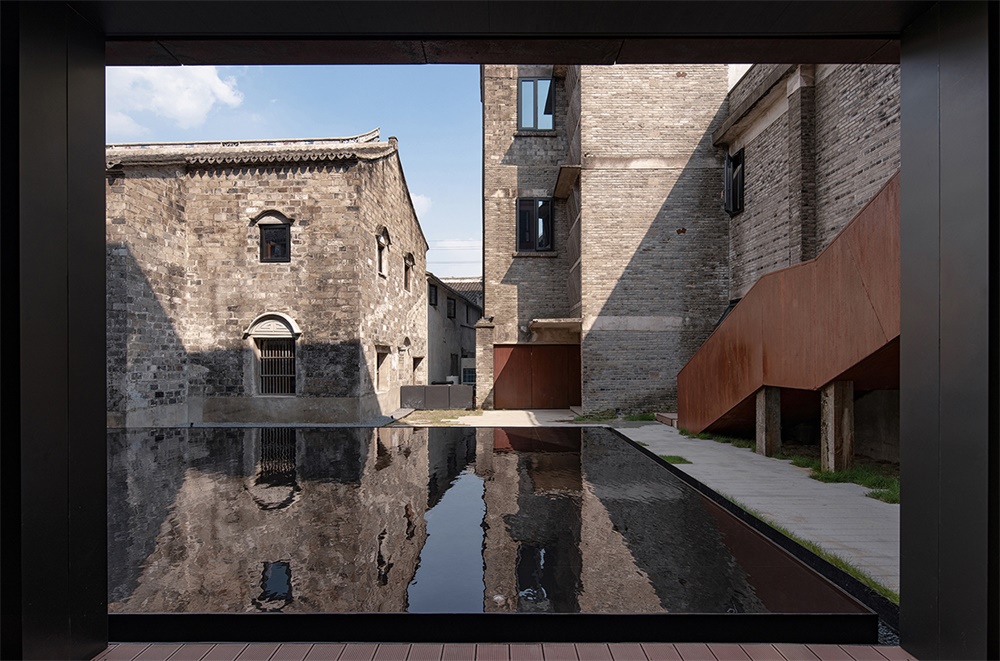
時空回廊 Space-time corridor
並置不同年代建築曆史傳承的“時空回廊”
Space-time corridors which make historical architectures of different ages coexist.
設計以“時空回廊”是作為改造理念的主線,串聯起場地現有清末民初、解放後和改革開放三個不同曆史時代的建築。這些老建築雖已有些殘敗,但仍保留著在它們的年代,對於建築美感和空間功能的理解,磚木間訴說著不同的曆史故事。設計試圖還原並且強化在這同一天地中曆史時空的碰撞,讓每一個不同年齡段、不同背景的人來到這裏,都能找到觸動內心的屬於一個時代的理解。
The design takes “space corridor” as the main line of concept, and connects the existing buildings in the three different historical eras in the late Qing Dynasty, early Republic of China, post-liberation and reform and opening up. Although these old buildings have been somewhat ruined, they still retain their unique aesthetic and spatial functions. The design attempts to restore and strengthen the contrast of different historical buildings, so that every person of different ages and backgrounds can find an understanding that touches their hearts.
∇ 內庭院,攝影:吳清山 After:Inner Courtyard Landscape, photo: Wu Qingshan
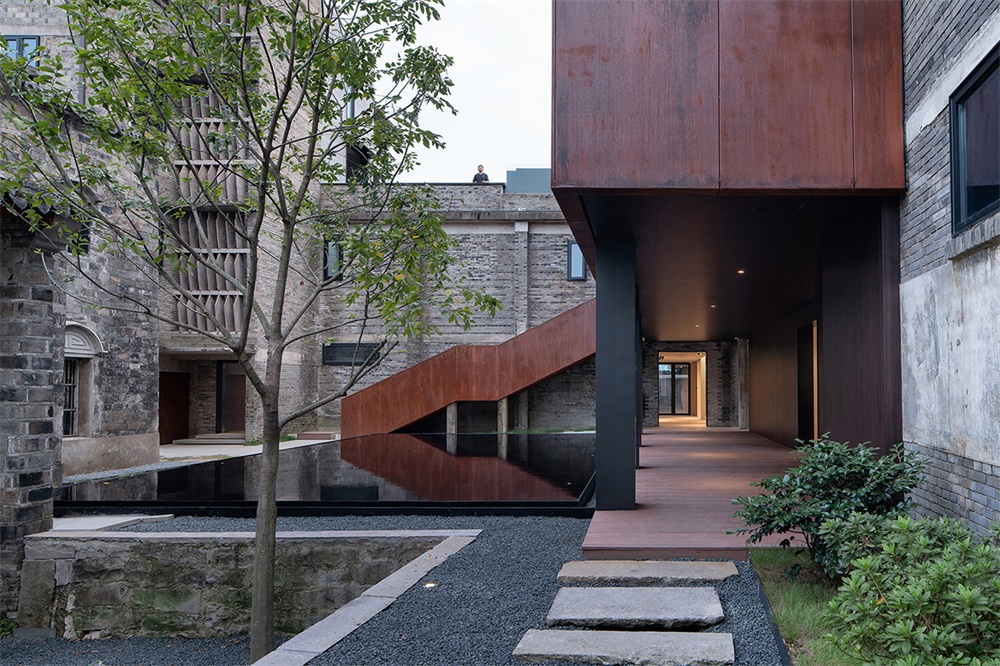
∇ 內庭院水景,攝影:吳清山 Inner Courtyard Landscape, photo: Wu Qingshan
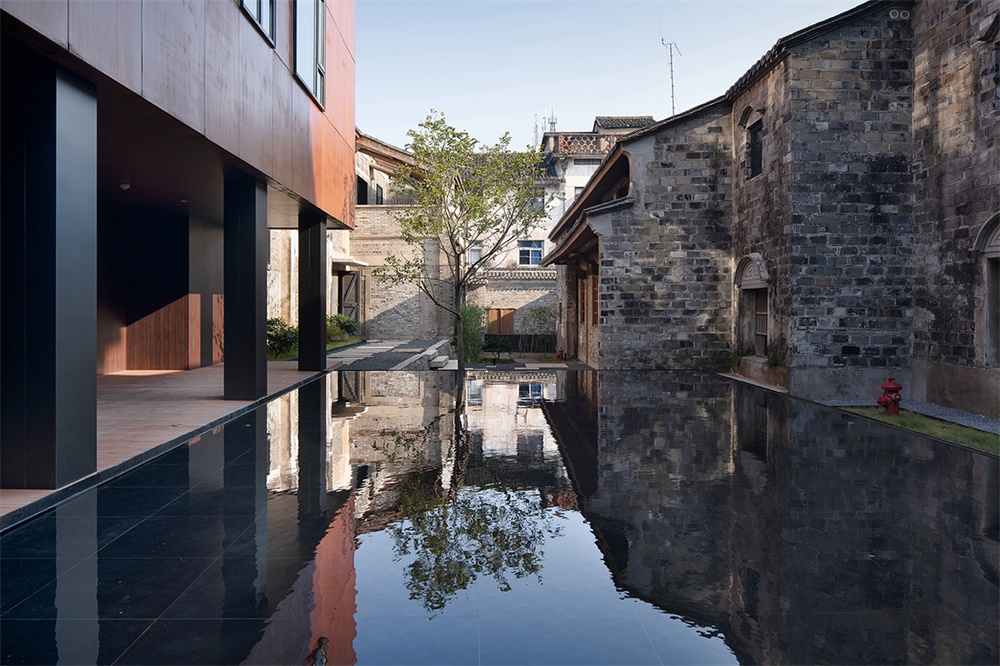
∇ 內庭院,攝影:王寧 Inner Courtyard Landscape, photo: Wang Ning
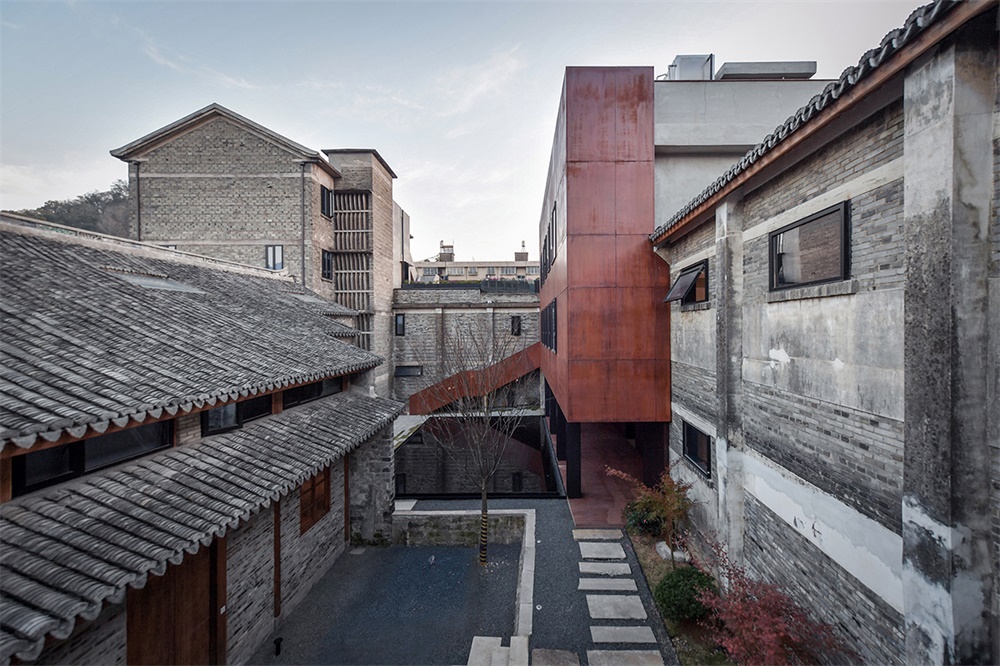
麵對不同年代的老建築,保留其現有的外觀並采用為其“量身打造”的改造策略。對於100年曆史的四合院,修舊如舊,盡可能的還原屬於曆史院落的生氣,在細節上保留曾經的“當鋪記憶”,再為其注入新的生命力;對於60年曆史的兩幢工業遺存建築,保留一部分曆史和工業痕跡,在整體建築修繕的同時,通過局部加入當代空間感受和空間使用方式,產生一種戲劇化的空間對話。
Facing the buildings of different ages, retain its existing appearance and adopt a retrofit design strategy for it. For the 100-year-old Siheyuan, the restoration restored the vitality of the historical courtyard as much as possible, retaining the former “pawnshop memory” in details, and injecting new vitality into it. For the two industrial buildings with a history of 60 years, part of the historical and industrial traces are retained. While the overall building is being repaired, the contemporary space function is partially added to create a dramatic spatial effect.
∇ 屋頂花園視角,攝影:吳清山 Overview from Roof Garden, photo: Wu Qingshan
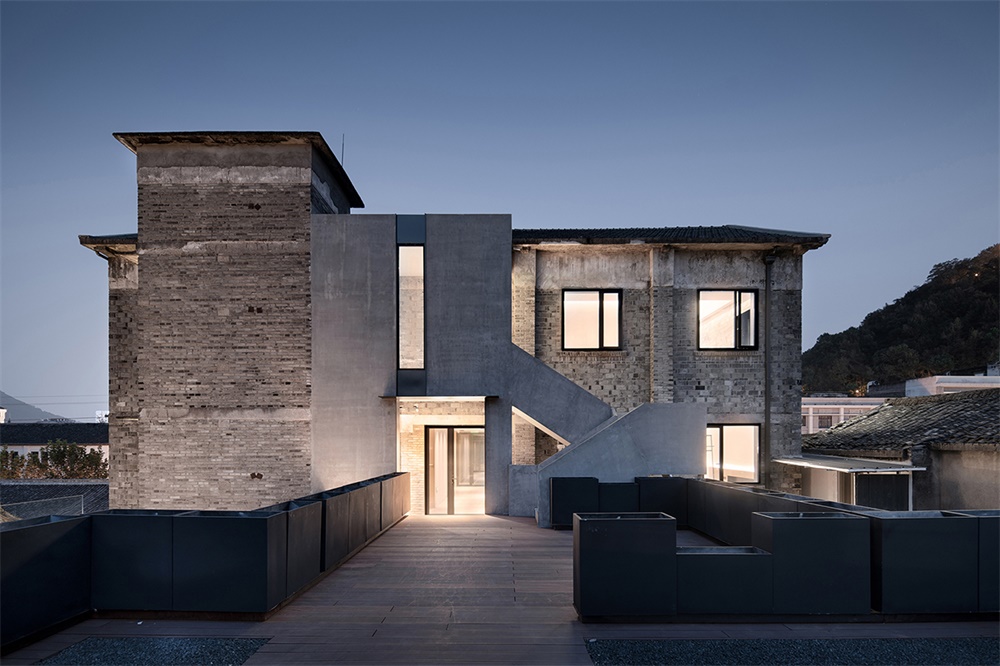
對於20年曆史的倉庫建築,在保留建築原有框架的基礎上,進行較大幅度創新動作,從外觀便以鏽金屬板特立呈現,讓建築在透出更多現代的氣息。三種不同年代的交織,在內庭院環繞,展現出三種不同曆史聲音的“時空回廊”。
For 20-year-old warehouse buildings, more innovations are made on the basis of retaining the original structural framework. From the exterior, it is presented with rusty metal plates, allowing the building to reveal a more modern atmosphere. The interweaving of three different ages, surrounded by the inner courtyard, reveals three different historical “space corridors”.
∇ 從建築外廊看老城,攝影:吳清山 Overview, photo: Wu Qingshan
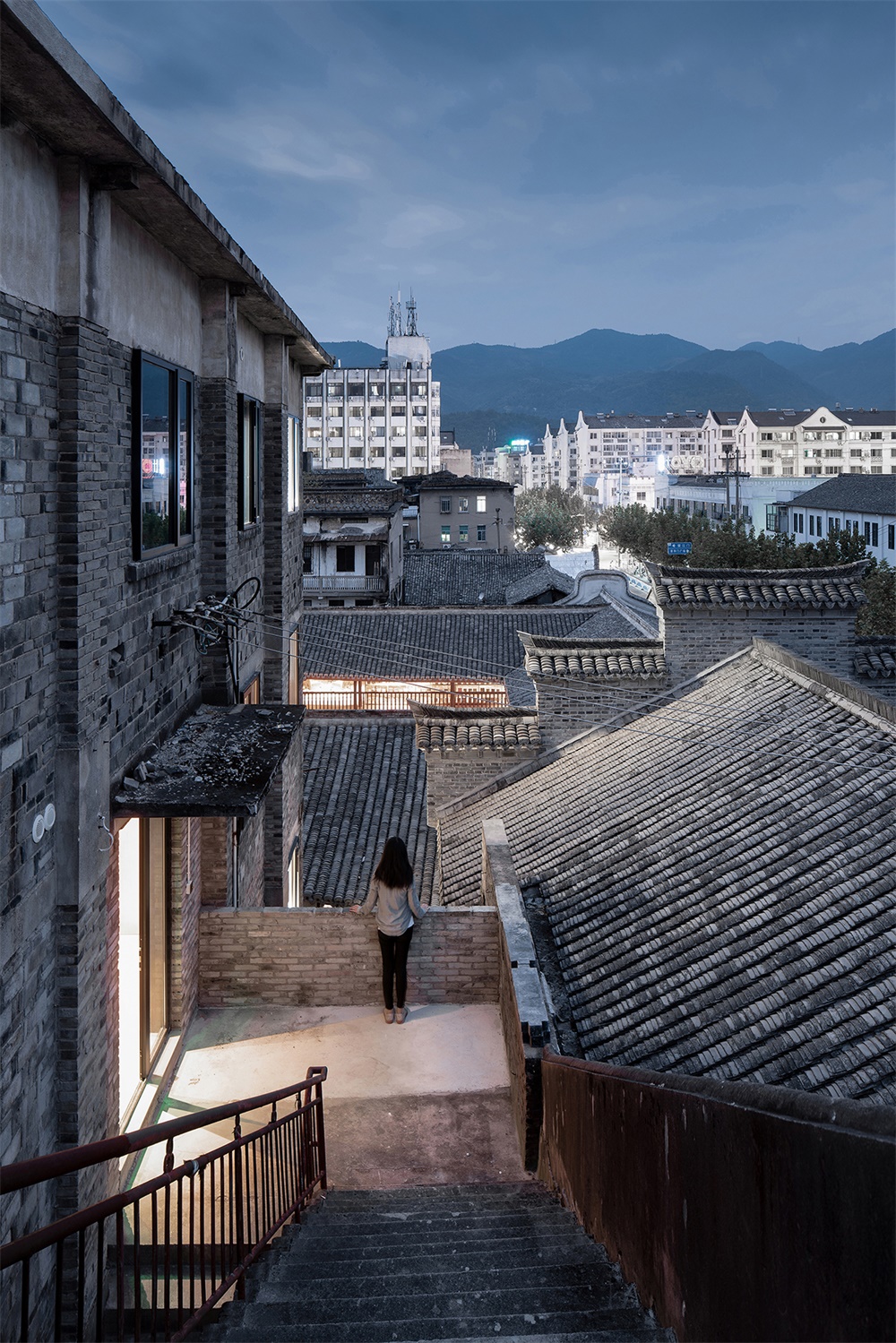
城市客廳 Urban living room
將民宿公共功能拓展為城市街道生活的延伸
Expanding public function spaces into extensions of urban life
∇ 咖啡吧,攝影:吳清山 Cafe, photo: Wu Qingshan
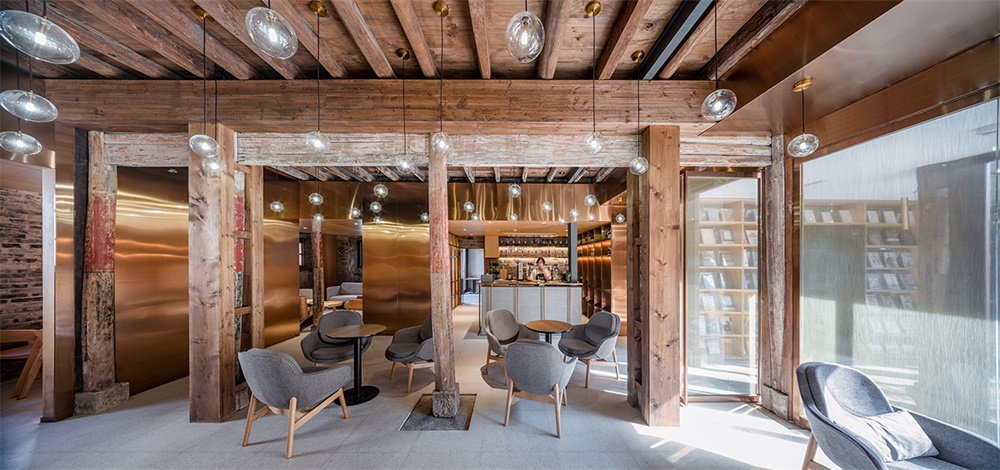
四合院的改造設計,在更多的保留現狀的基礎上加以修繕,讓其作為民宿公區的同時,也打造為麵向城市居民和遊客開放的“城市客廳”。在內部選擇局部空間進行一二層通高設計,作為或書館、或眾創空間、或會客、或咖啡吧等功能使用,也是設計中具有反差力的記憶點,讓局部的改變完成四合院整體的複蘇。
The reconstruction design of the courtyard house was repaired on the basis of retaining as much of the status quo as possible. While making it a homestay area, it is also created as an “urban living room” open to urban residents and tourists. A part of interior space was selected for a two-story high-height design. It was used as a bookstore, guesthouse, or coffee bar, etc.
∇ 四合院書館,攝影:吳清山 Coutyard Bookstore, photo: Wu Qingshan
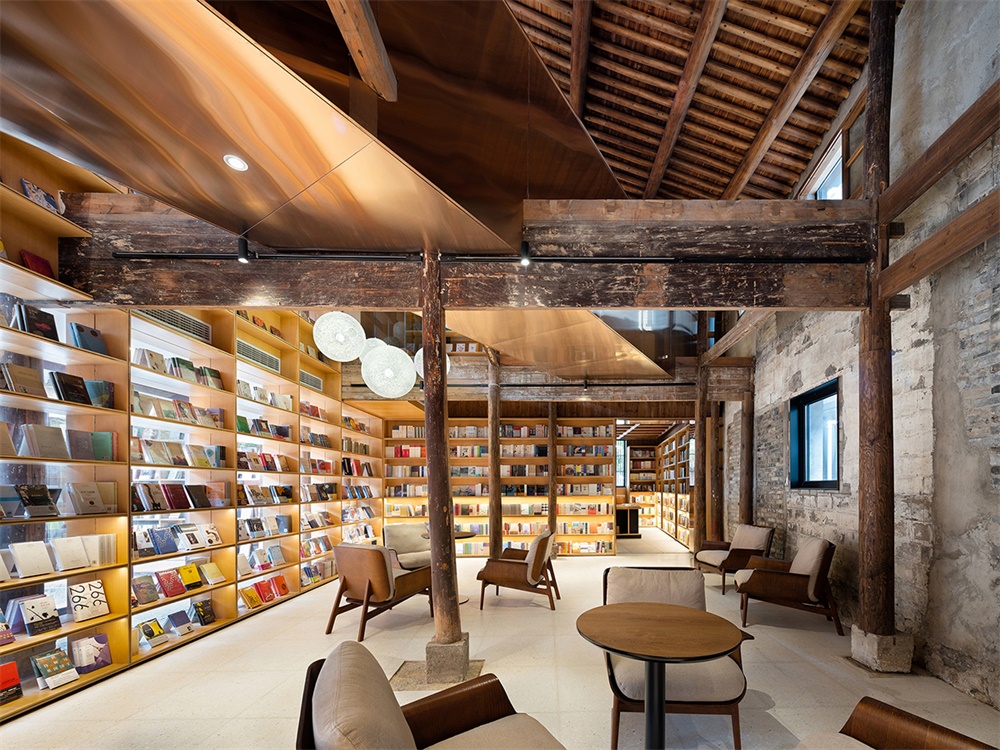
∇ 四合院咖啡吧和餐廳,攝影:吳清山 Coutyard Cafe & Dining Room, photo: Wu Qingshan
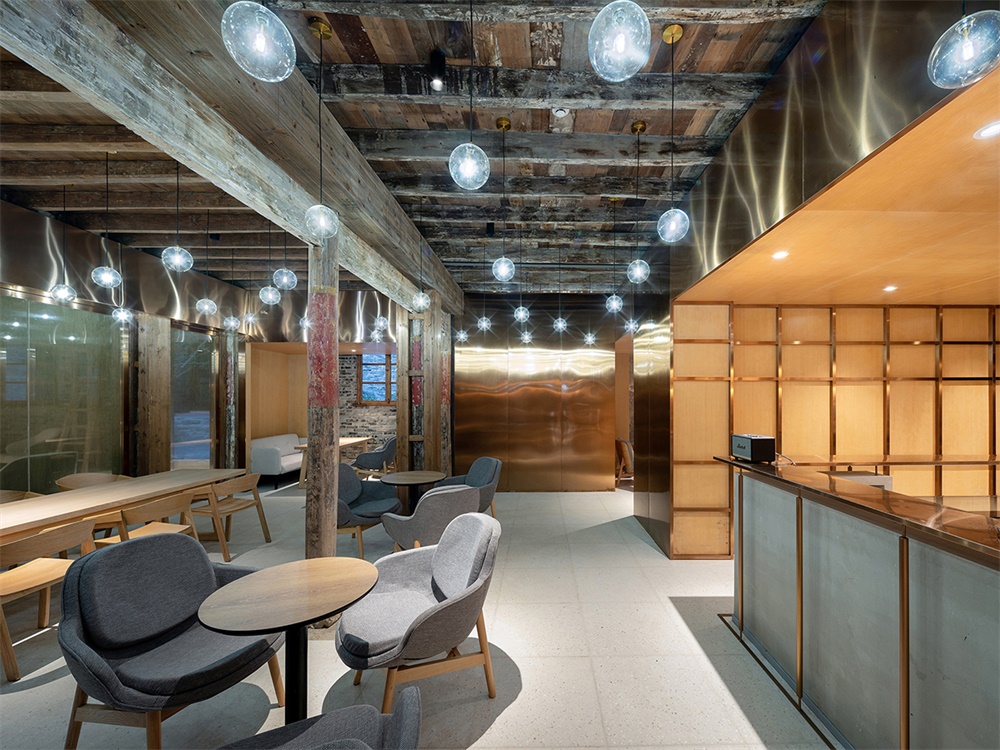
“城市客廳”把原來分裂開來的城市公共活動整合在一起,對內作為民宿的服務功能,提升居住的配套附加值;對外向城市開放,成為城市人群活動、聚會、交友、學習等聚集地。而同樣重要的是,通過公共區域與民宿區域的分區管理,依舊保證民宿區域的私密性與專屬性。
“Urban living room” integrates the original messy urban public activities together. The internal service function as a homestay enhances the added value of living facilities, at the same time, it is open to the city to become a gathering place for urban crowds to make activities, make friends, and learn. It is also important that the privacy of the homestay area is still guaranteed through the partition management of the public area and the homestay area.
∇ 四合院樓梯空間,攝影:吳清山 Coutyard Stairs, photo: Wu Qingshan
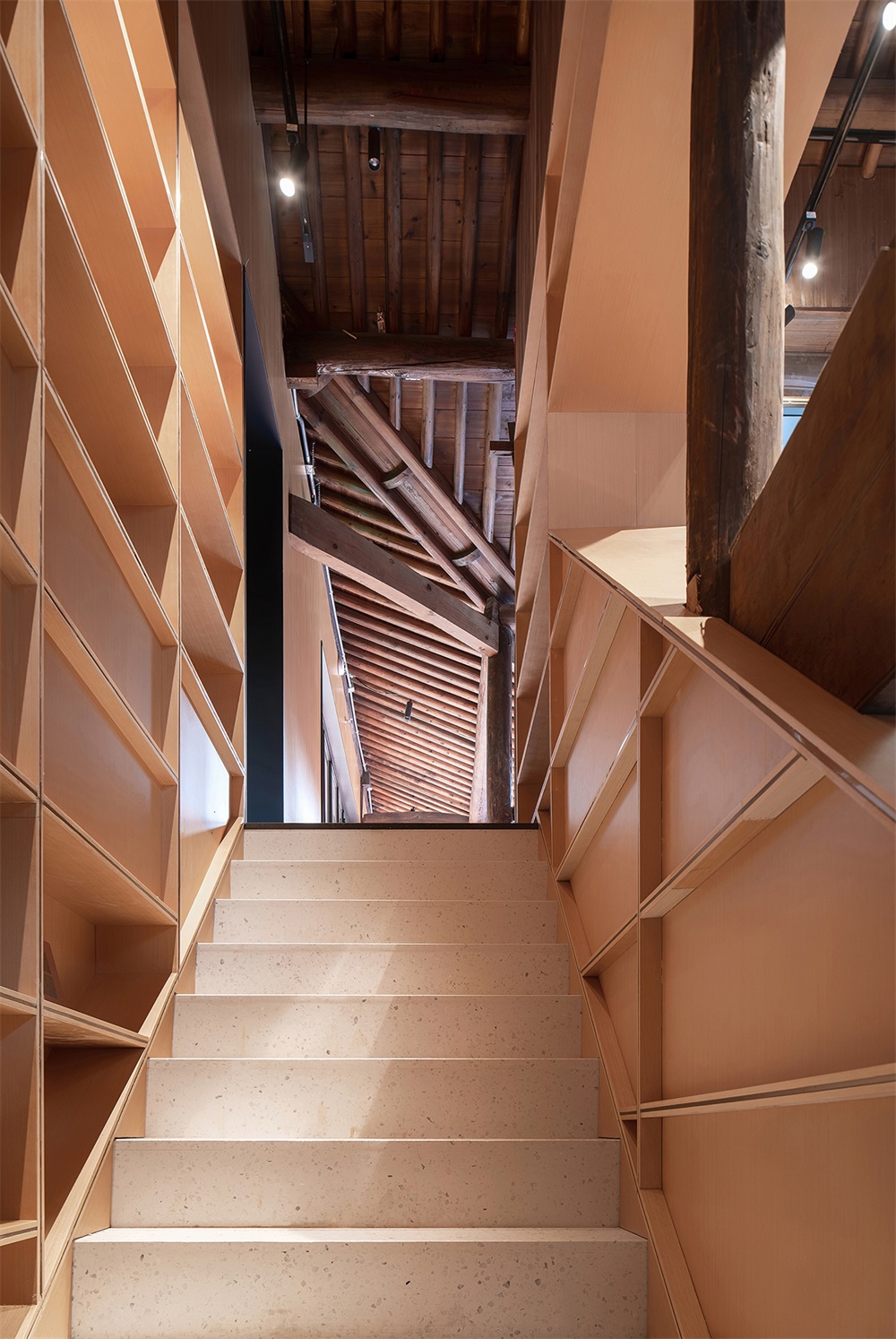
∇ 四合院二層多功能廳,攝影:王寧 Coutyard Multifunction Space, photo: Wang Ning
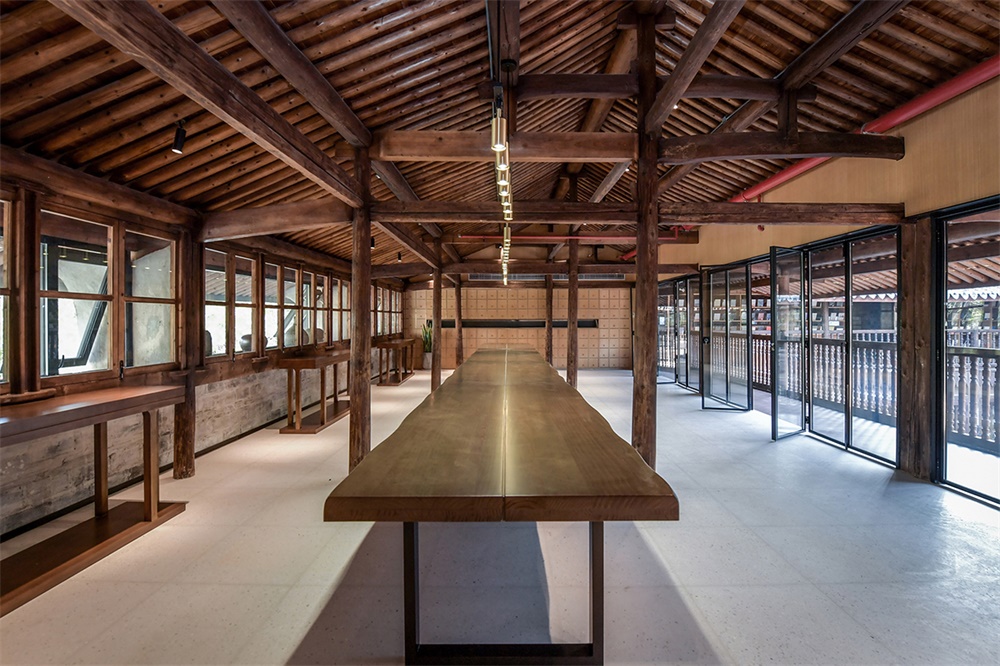
∇ 四合院會議廳的“當鋪記憶”細節,攝影:王寧 “Pawnshop Memory” Details, photo: Wang Ning
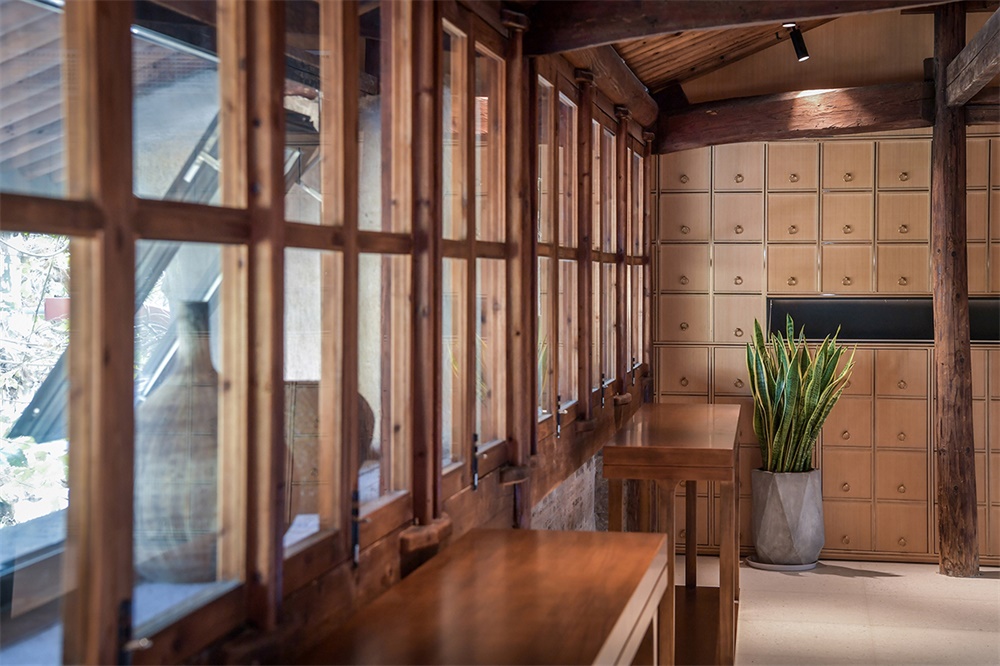
居住對話 Experiential living
以使用者行為作為中心出發的居住空間體驗 Experiential living space based on user behavior
客房室內空間設計不再以傳統酒店的“居住”功能為核心,而是真正站在使用者角度,突破使用功能禁錮,營造場景下的居住體驗,將使用者行為作為核心出發點。空間作為身心經驗的載體,以不同曆史年代建築的體驗感受為主題,為每個客房量身定製身心之旅。通過設計把某一特定行為進行放大,用新的方式來創造人與曆史空間的對話。
The interior design of guest rooms is no longer centered on the “living” function of ordinary hotels. Instead, the user behavior is the core to create a living experience in the scene. The space serves as the carrier of physical and mental experience, and the theme of the guest rooms is the experience of buildings in different historical ages. Amplify a specific behavior through design, and create a new way of dialogue between man and historical space.
∇ 90年代建築客房,攝影:吳清山 90s Guest room, photo: Wu Qingshan
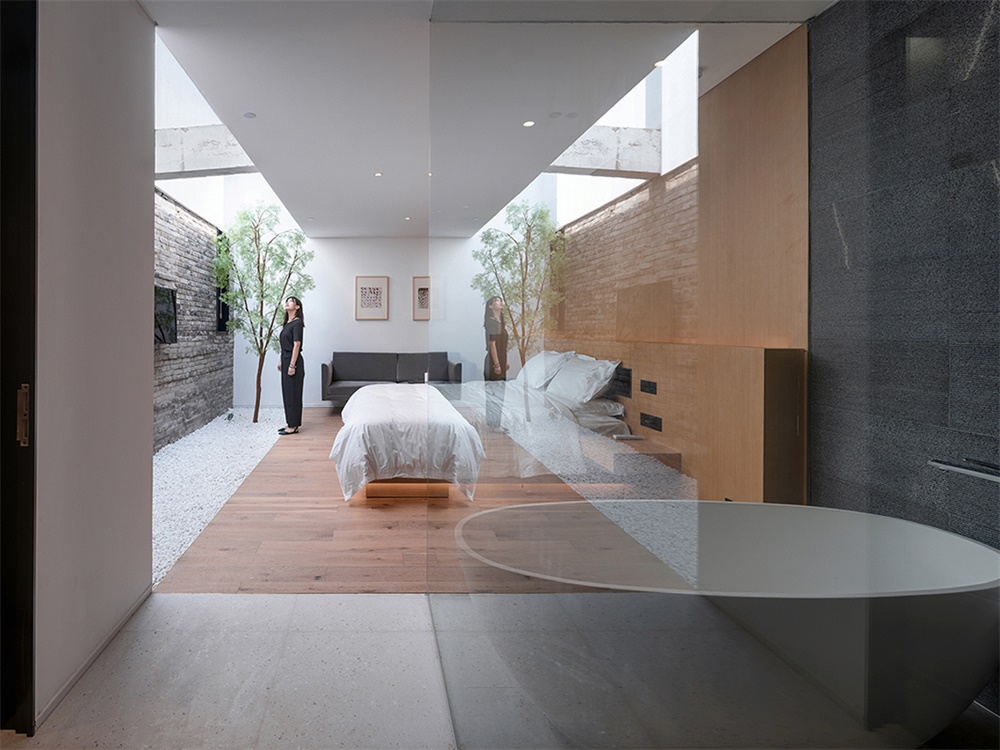
四合院客房:“星空下”的曆史暢想 Courtyard Guest Room: Historical Imagination “Under the Sky”
老建築原有的木梁柱結構自然、純粹,為保留其本初的美感,設計首先將老建築的木結構修複和直接裸露作為室內空間的自然劃分和主基調,局部點綴既與之相和諧又增加現代氛圍的家具。屋頂的木椽石瓦被打開一方天光,在引入自然光線的同時,營造將使用者帶入“星空下”百年曆史暢想的居住美感中。
The original wooden beam and column structure of the old building is natural and pure. In order to retain its original beauty, the design first used the restoration and direct exposure of the wooden structure as the division and main tone of the interior space. The furniture was locally harmonious and added a modern atmosphere. While opening a pane on the roof to introduce natural light, it creates a living aesthetic that brings users into the imagination of the century-old history.
∇ 四合院“星空下”客房,攝影:吳清山 Courtyard Guest Room, photo: Wu Qingshan
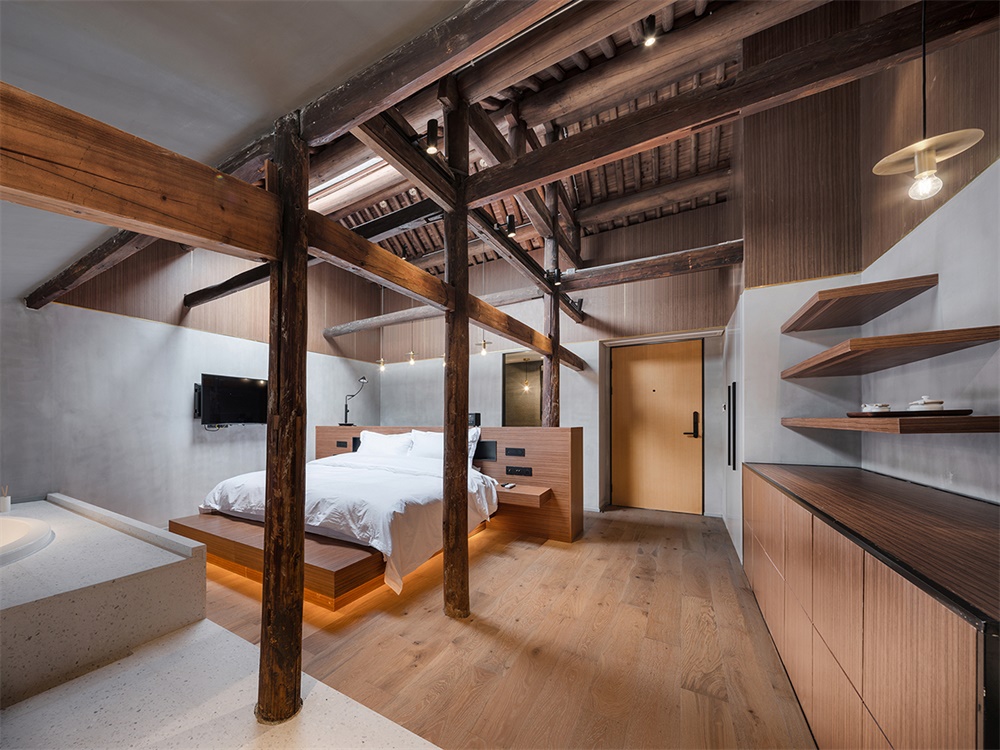
∇ 四合院客房,攝影:吳清山 Courtyard Guest Room, photo: Wu Qingshan
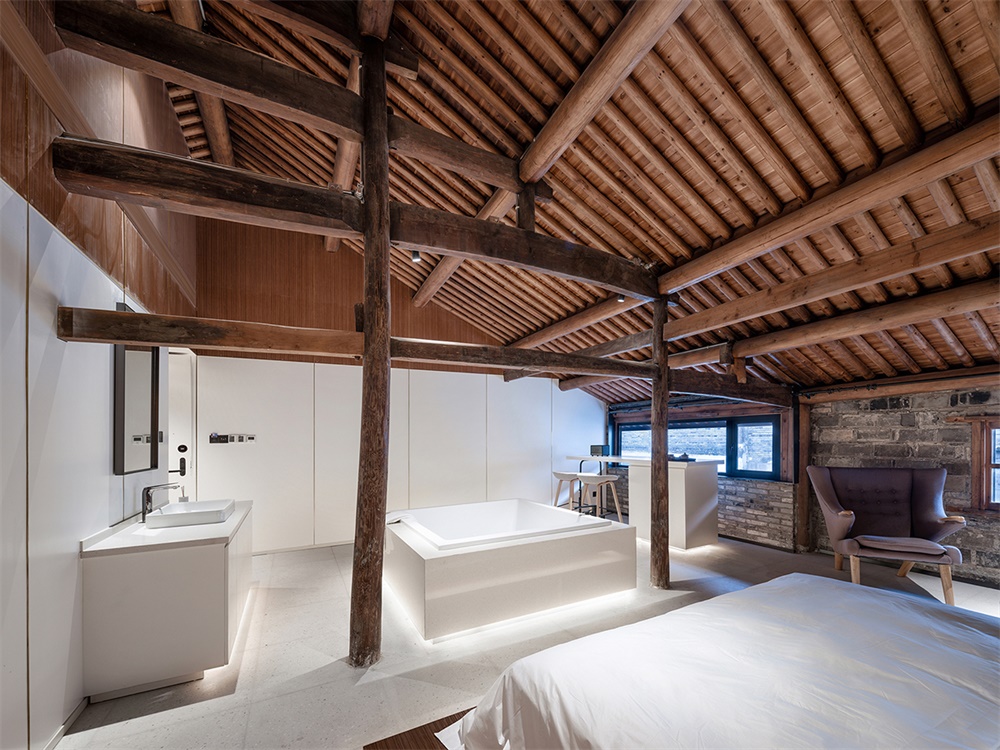
∇ 四合院客房,攝影:吳清山 Courtyard Guest Room, photo: Wu Qingshan
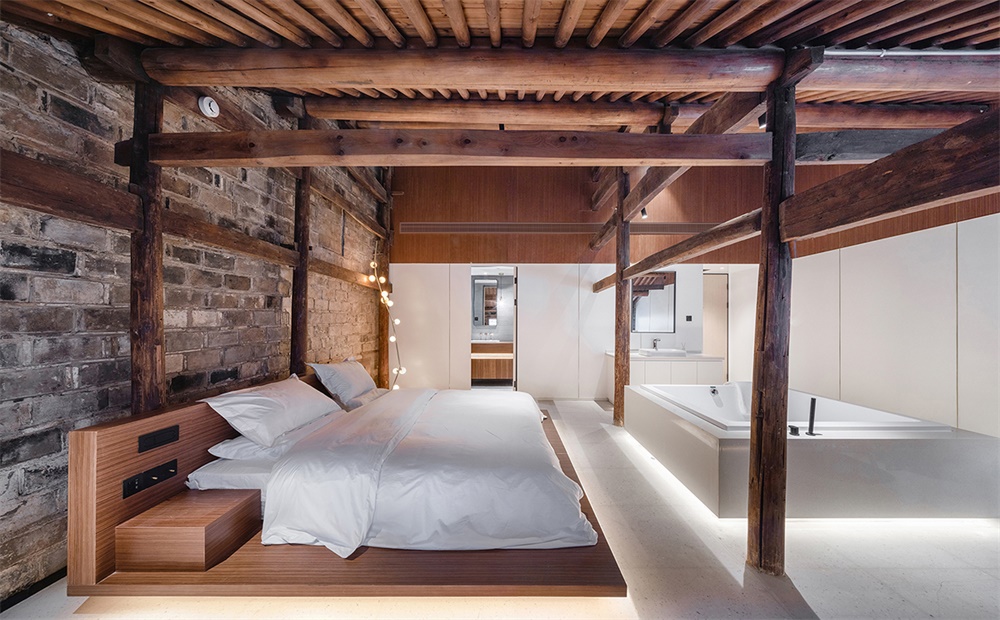
60年代建築客房:50%傳統+50%現代 60s Guest Rooms: 50% Traditional + 50% Modern
60年代建築客房的室內呼應建築的改造策略和氛圍,在”一半”傳統結構中注入”一半”的現代梳理,保留了具有曆史質感的青磚和混凝土結構,將主體居住功能置入客房的中心位置,給使用者足夠的空間留白體驗。
The interior of the guest room echoes the reconstruction strategy and atmosphere of the 60s building, injecting “half” of modern combing into the “half” of the traditional structure. The brick and concrete structure with historical texture is retained, and the main living function is placed in the center of the guest room, giving the user a sense of sufficient space.
∇ 60年代建築客房,攝影:吳清山 60s Guest Rooms, photo: Wu Qingshan
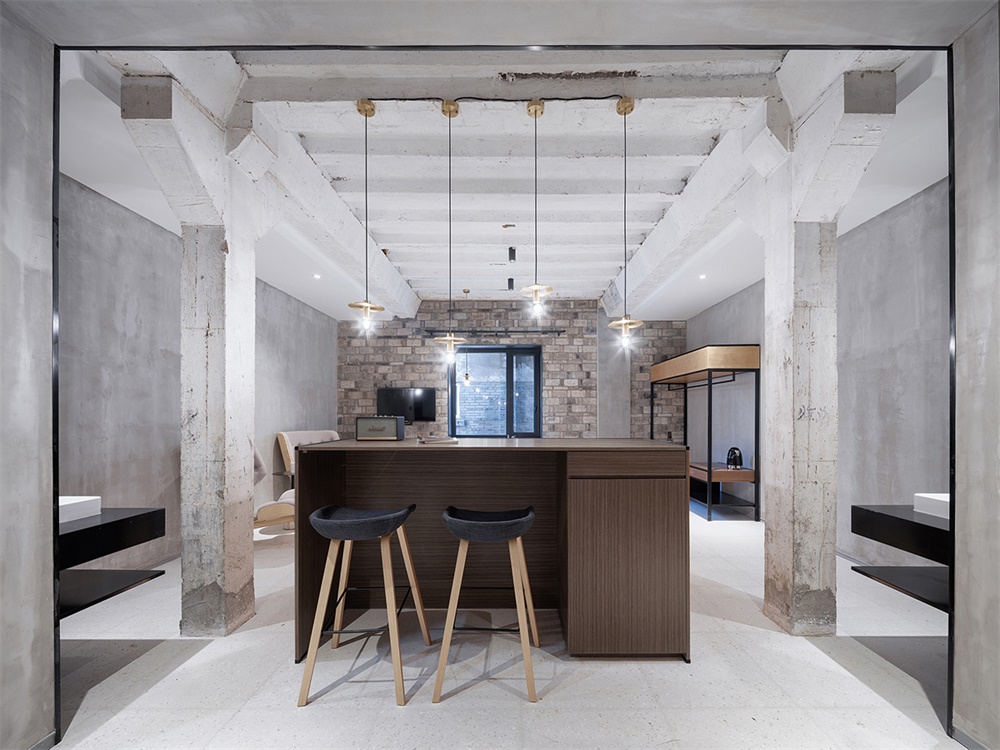
∇ 60年代建築客房,攝影:吳清山 60s Guest Rooms, photo: Wu Qingshan
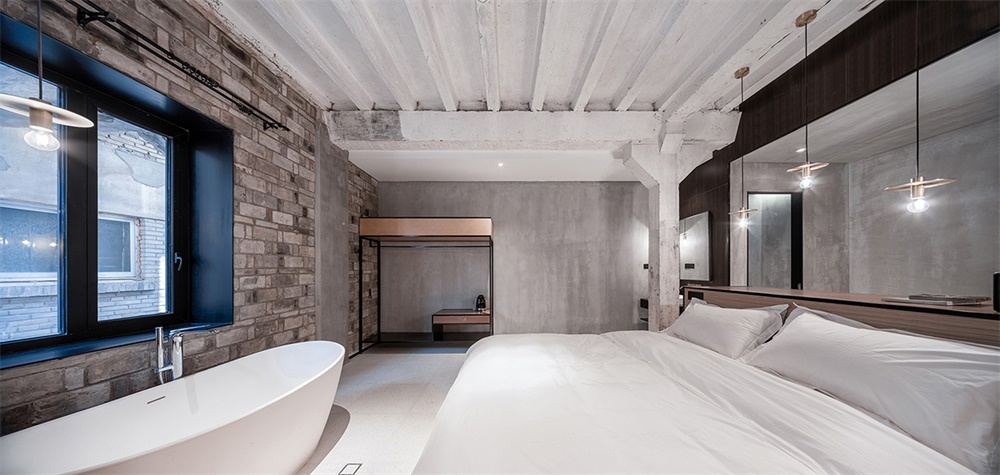
∇ 60年代建築公區,攝影:吳清山 60s Guest Rooms, photo: Wu Qingshan
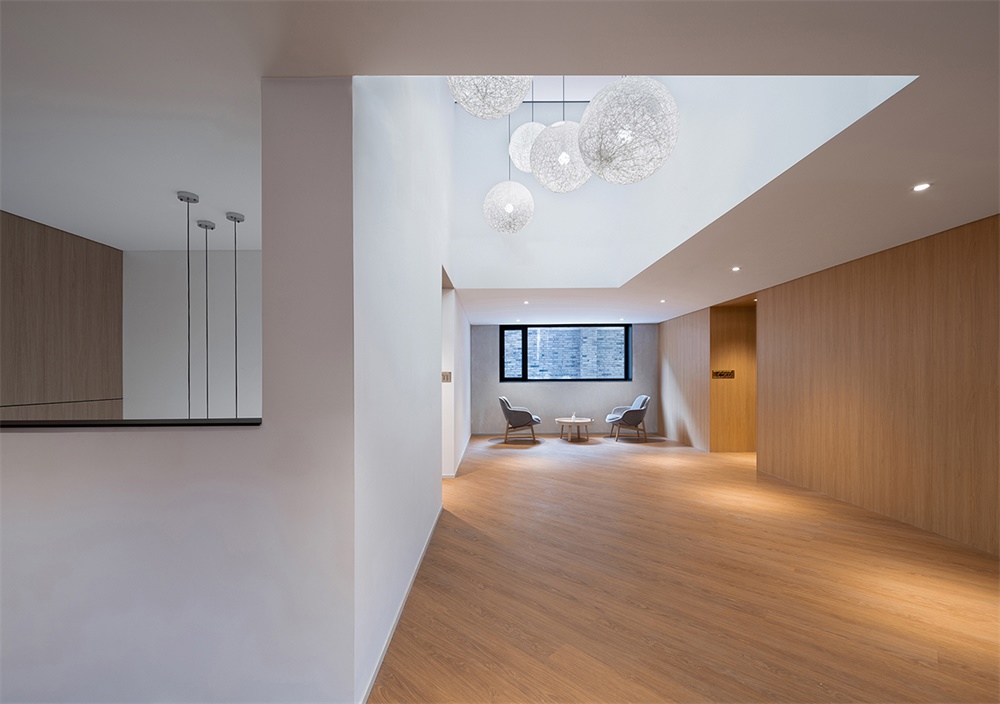
∇ 樓梯空間,攝影:吳清山 Stairs, photo: Wu Qingshan
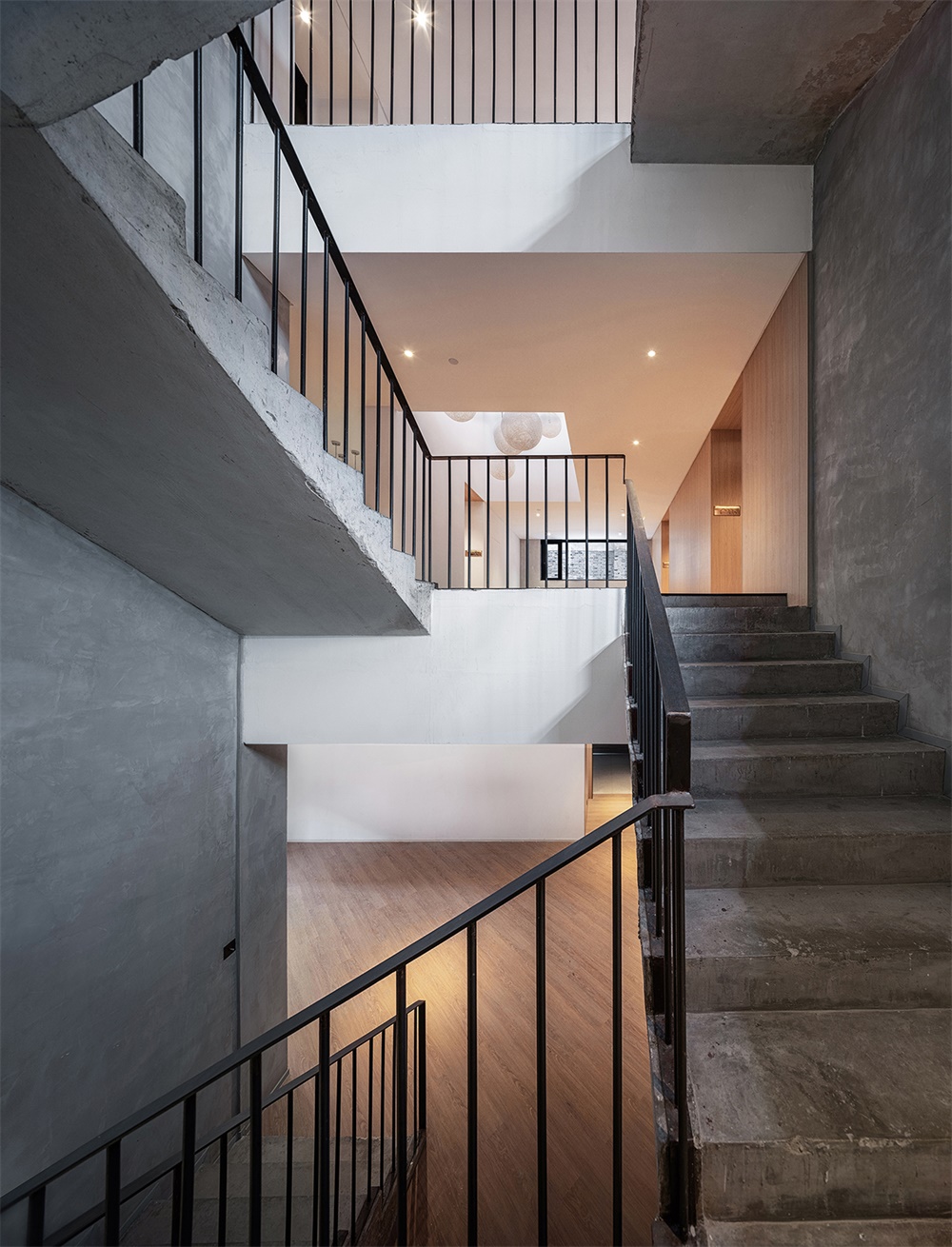
90年代建築客房:20%傳統+80%現代 90s Guest Rooms: 20% Traditional + 80% Modern
90年代建築客房中的傳統元素被選擇性篩留,轉變為局部的細節展現,大量木色空間包裹營造出更為現代式溫馨的居住氛圍,為追崇更加時尚簡潔居住感受的使用者提供選擇。
The traditional elements in the architectural rooms of the 1990s were selectively screened and transformed into partial details. A large number of wood-colored spaces created a more modern and warm living atmosphere, providing users with choices in pursuit of more stylish and simple living experiences.
∇ 90年代建築客房,攝影:吳清山 90s Guest Rooms, photo: Wu Qingshan
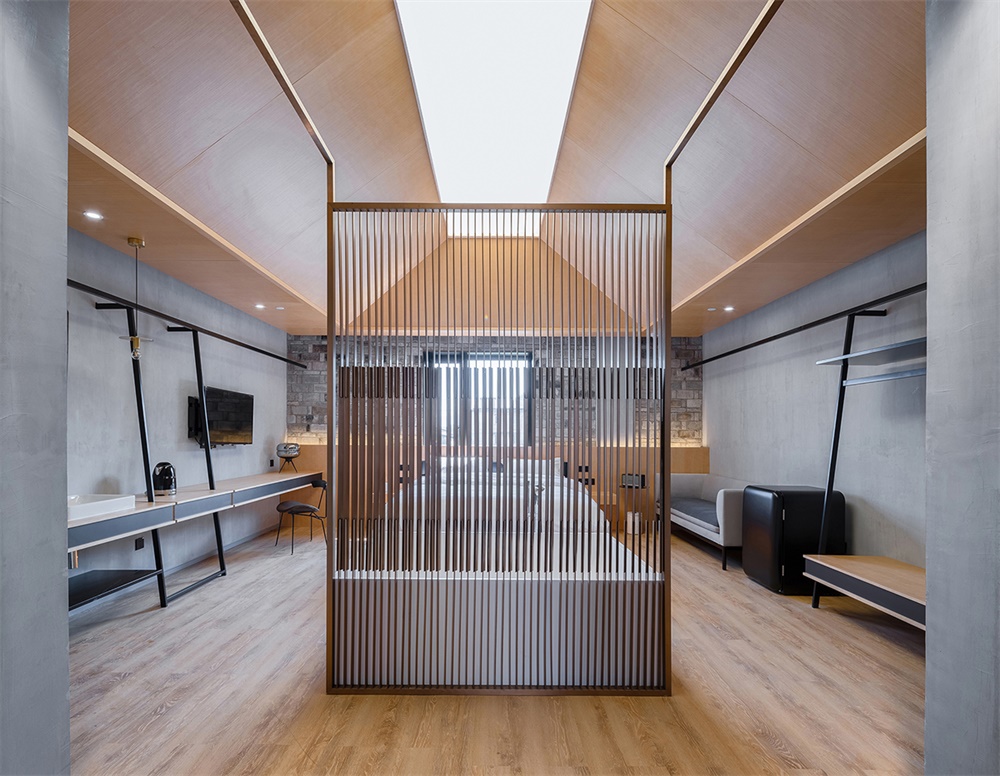
∇ 90年代建築客房,攝影:吳清山 90s Guest Rooms, photo: Wu Qingshan
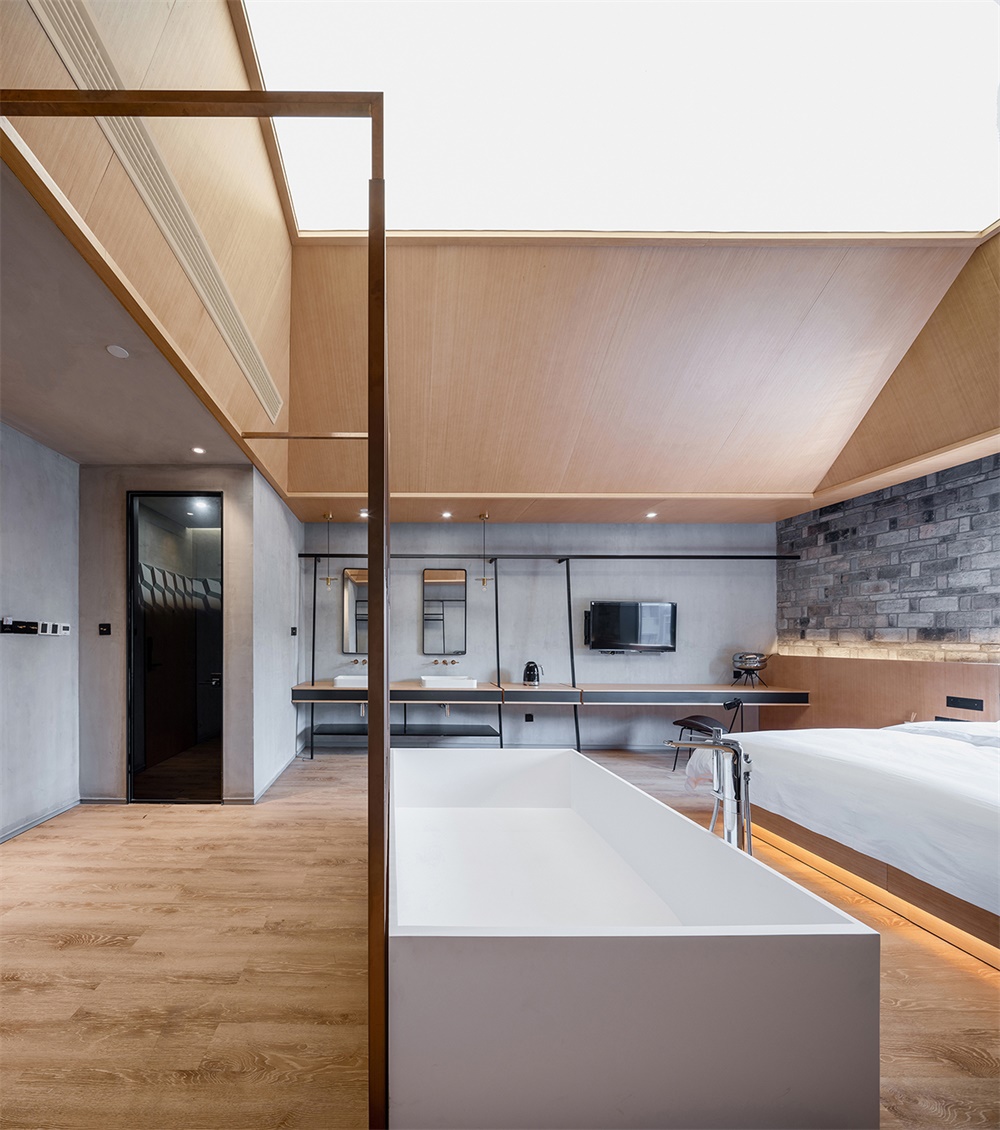
∇ 客房公區,攝影:吳清山 Public Space, photo: Wu Qingshan
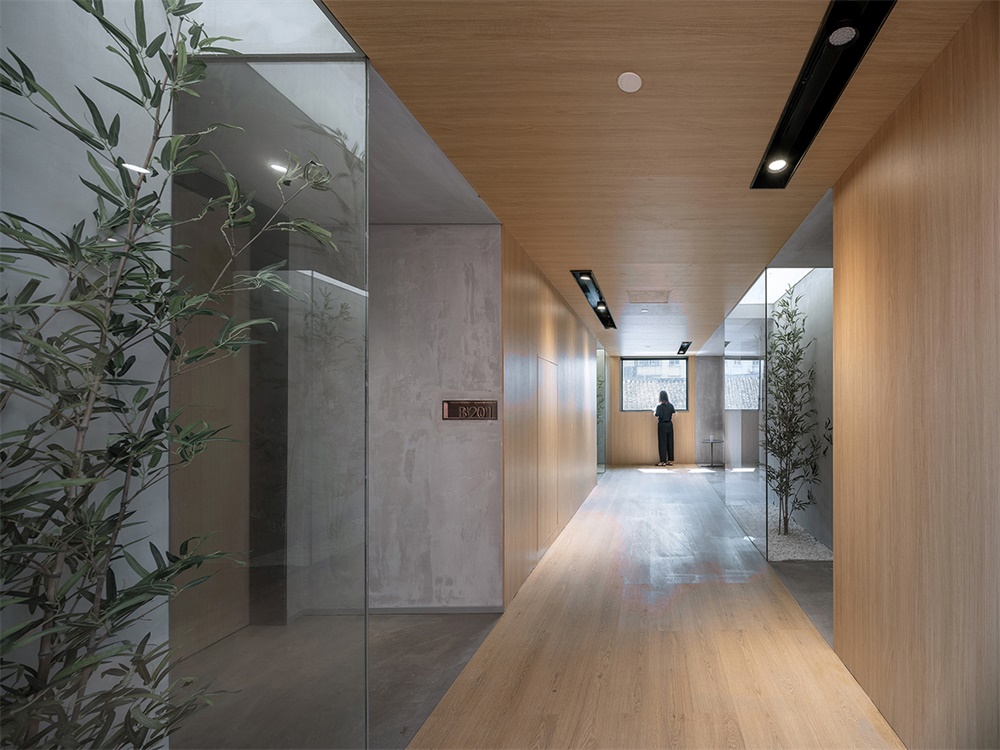
∇ 客房軟裝細節,攝影:王寧 Soft Decoration Details , photo: Wang Ning
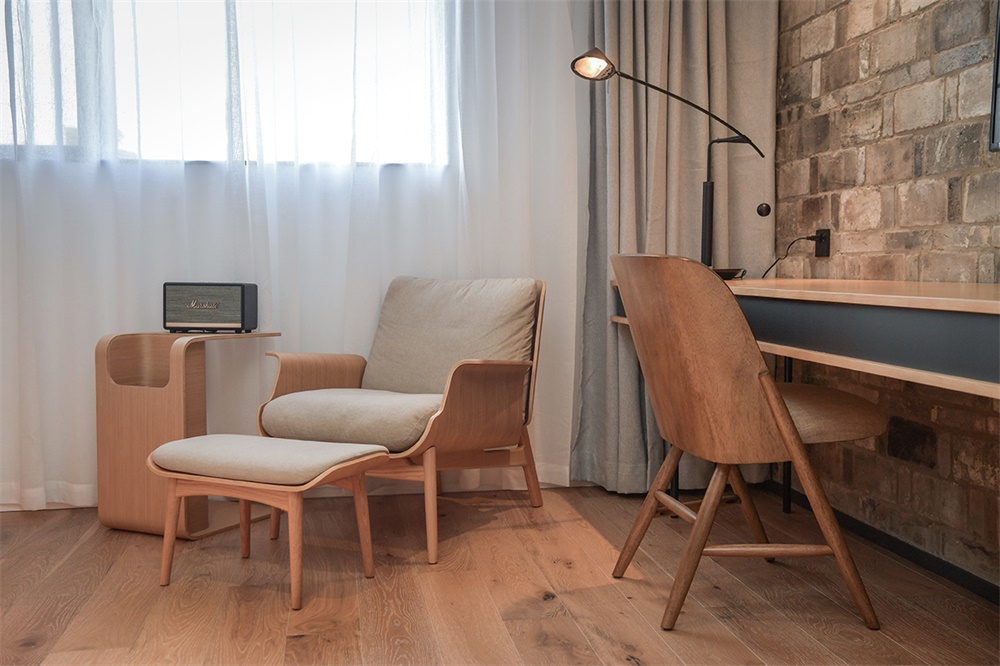
∇ 客房軟裝細節,攝影:王寧 Soft Decoration Details , photo: Wang Ning
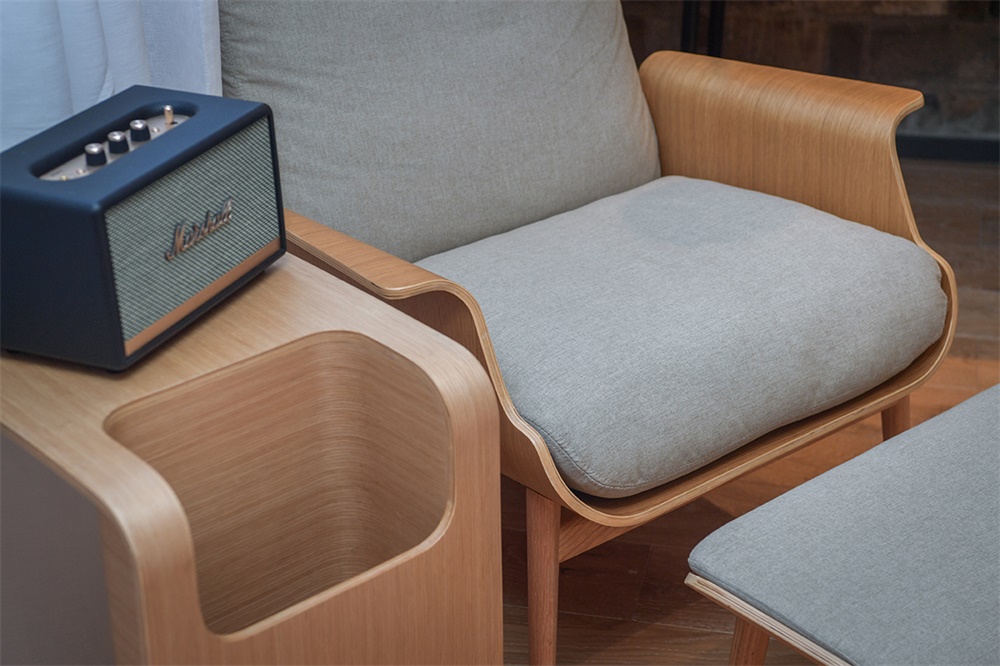
∇ 首層總平麵圖 ©零壹城市建築事務所 Ground Floor Plan ©LYCS Architecture
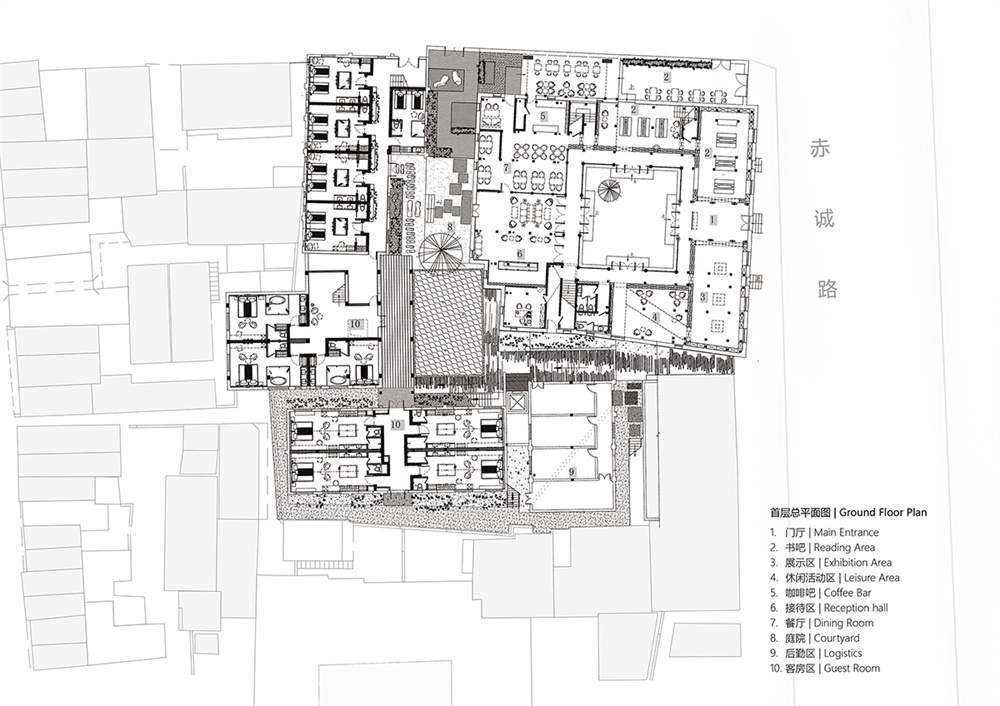
主要項目信息
項目名稱:臨海餘豐裏精品酒店
項目地點:中國 台州 臨海
建築麵積:3,298平方米
項目時間:2017-2018 年(設計) 2018-2019年(施工)
設計公司:零壹城市建築事務所(建築設計、室內設計、軟裝設計、VI設計)
設計團隊:阮昊、詹遠、何昱樓、張秋豔、嵇涵、楊莉、趙一凡、範笑笑、王浩然
合作景觀設計:章萬清,林海
攝影師:吳清山、王寧
Project name: Linhai Yufengli Homestay
Location: Taizhou Linhai, China
Size: 3,298 sq.m
Project Period: 2017-2018(Design) 2018-2019(Construction)
Design Firm : LYCS Architecture (Architecture, Interior, Soft Decoration and VI Design)
Project Team: RUAN Hao, ZHAN Yuan, HE Yulou, ZHANG Qiuyan, JI Han, YANG Li, ZHAO Yifan, FAN Xiaoxiao, WANG Haoran
Cooperative Landscape Design: ZHANG Wanqing
Photographer: WU Qingshan, WANG Ning


